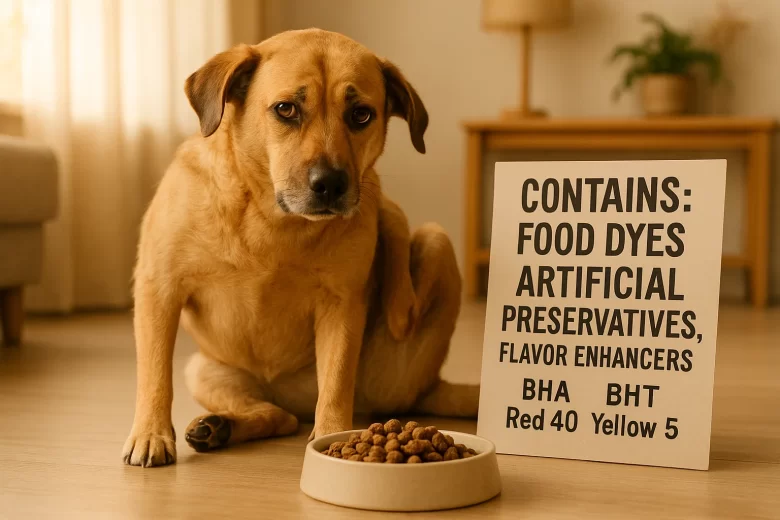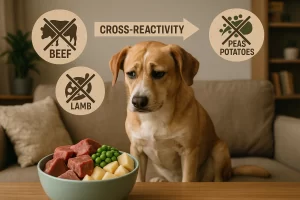As a dog owner, you always want the best for your furry friend. One of the most important aspects of ensuring your dog’s health is providing them with the right food. However, some dogs may have sensitivities or allergies to certain ingredients commonly found in commercial pet food, such as food dyes and preservatives. These ingredients are often added to enhance the color, taste, and shelf life of dog food, but they can cause allergic reactions in some dogs. In this article, we’ll explain how to identify these ingredients on food labels and how to eliminate them from your dog’s diet.
Understanding Food Dye and Preservative Allergies in Dogs
Food dye and preservative allergies in dogs are becoming more common as pet food manufacturers increasingly use artificial additives to improve the appeal and shelf life of products. These artificial ingredients can lead to a variety of allergic reactions in dogs, including skin irritations, digestive problems, and behavioral changes.
Food dye, which is often used to make food look more appealing, can contain harmful chemicals like Red 40, Yellow 5, and Blue 2, which can trigger allergic reactions in sensitive dogs. Similarly, preservatives like BHA, BHT, and Ethoxyquin are used to extend the shelf life of dog food, but they can cause adverse effects in some pets.
It’s important to note that while these ingredients are generally recognized as safe for humans, they can have negative effects on dogs, especially those with sensitive systems.
Common Allergic Reactions to Food Dyes and Preservatives
Dogs who are allergic to food dyes and preservatives may experience a range of symptoms. These reactions can vary from mild to severe, and they can affect both the digestive system and the skin. Some common symptoms of food dye and preservative allergies in dogs include:
1. Skin Irritations
One of the most common allergic reactions to food dyes and preservatives is skin irritation. Dogs may develop:
- Itchy skin
- Redness or inflammation
- Hot spots
- Hair loss
These skin issues are often the result of the immune system reacting to the artificial chemicals in the food, causing inflammation and discomfort.
2. Gastrointestinal Issues
Food dyes and preservatives can also affect a dog’s digestive system. Common gastrointestinal symptoms include:
- Vomiting
- Diarrhea
- Gas and bloating
- Loss of appetite
These symptoms may appear shortly after eating food containing artificial additives, indicating that the dog’s body is rejecting the harmful chemicals.
3. Behavioral Changes
In some cases, dogs with food dye and preservative allergies may show behavioral changes. These can include:
- Increased hyperactivity or restlessness
- Lethargy or fatigue
- Irritability
- Excessive licking or chewing of paws
These changes in behavior may occur because of the discomfort caused by the allergic reaction, making the dog feel uneasy or agitated.
4. Ear Infections
Food allergies, including those triggered by artificial colors and preservatives, can also contribute to chronic ear infections in dogs. Symptoms may include:
- Excessive scratching of the ears
- Discharge from the ears
- Odor or redness inside the ear
If your dog frequently suffers from ear infections and other allergic reactions, food additives might be the culprit.
How to Identify Food Dyes and Preservatives on Labels
Identifying food dyes and preservatives in dog food can be tricky, as these ingredients may not always be listed in a way that’s easy to understand. However, there are several key strategies to help you spot them on food labels.
1. Look for Artificial Colors
Artificial colors are often included in pet food to make it look more appealing, especially in dry kibble or treats. Common food dyes to watch out for include:
- Red 40 (Allura Red)
- Yellow 5 (Tartrazine)
- Blue 2 (Indigotine)
- Yellow 6 (Sunset Yellow)
These dyes are usually listed by their chemical names on the label. If you see any of these listed as ingredients, it’s a sign that the food may contain artificial colors that could trigger an allergic reaction in your dog.
2. Check for Preservatives
Preservatives are added to dog food to prevent spoilage and extend shelf life, but they can cause allergic reactions in some dogs. Common preservatives to watch for include:
- BHA (Butylated Hydroxyanisole)
- BHT (Butylated Hydroxytoluene)
- Ethoxyquin
- Propyl Gallate
- Sodium Nitrate and Nitrite
These preservatives are often used in low-quality dog foods, so it’s best to avoid them when choosing food for dogs with sensitivities.
3. Look for “Natural Flavors” or “Flavor Enhancers”
Many commercial dog foods list ingredients like “natural flavors” or “flavor enhancers” on their labels. While these ingredients may sound harmless, they can sometimes contain artificial additives or chemicals that may be harmful to your dog. If the food label doesn’t provide specific details on what makes up the flavoring, it’s better to avoid that product.
4. Avoid Synthetic Additives
Look for words like “artificial”, “synthetic”, or “chemical” on the label. These terms are often associated with artificial preservatives, colors, and flavor enhancers that can cause allergic reactions in dogs. Opt for foods with natural preservatives, such as Vitamin E (mixed tocopherols) or Vitamin C.
How to Eliminate Food Dyes and Preservatives from Your Dog’s Diet
The best way to avoid food dye and preservative allergies in your dog is to eliminate foods containing these ingredients from their diet. Here are some strategies for choosing safer food for your dog:
1. Choose High-Quality, Natural Dog Food
One of the best ways to avoid food dyes and preservatives is to choose high-quality, natural dog food. Look for brands that use whole ingredients and avoid artificial additives. These foods often contain fewer chemicals and more natural preservatives, making them a better choice for dogs with allergies.
2. Read Ingredient Labels Carefully
Make it a habit to read ingredient labels carefully before buying dog food. Look for products that are free from artificial colors, flavors, and preservatives. Choose foods that contain whole meats, vegetables, and grains, and avoid foods with vague or unfamiliar ingredients.
3. Consider a Homemade Diet
Another option is to prepare homemade meals for your dog. By cooking your dog’s food yourself, you can ensure that it’s free from artificial additives and preservatives. Consult with your veterinarian or a pet nutritionist to create a balanced diet tailored to your dog’s specific needs.
4. Opt for Limited Ingredient Diets
Limited ingredient diets (LID) focus on using a small number of high-quality ingredients, making them an excellent choice for dogs with allergies. These diets typically exclude artificial additives and preservatives, allowing you to control what your dog is eating.
5. Switch to Fresh or Freeze-Dried Pet Food
Fresh or freeze-dried pet food is often free from artificial preservatives and dyes. These foods are made with natural ingredients and are a great option for dogs with food sensitivities.
Conclusion
Food dye and preservative allergies are becoming more common in dogs, and it’s essential to be aware of the ingredients in your dog’s food. By reading labels carefully, avoiding harmful additives, and choosing high-quality, natural foods, you can help eliminate food dye and preservative allergies from your dog’s diet. Ensuring that your dog has a diet free from artificial chemicals will help them lead a healthier, more comfortable life.



